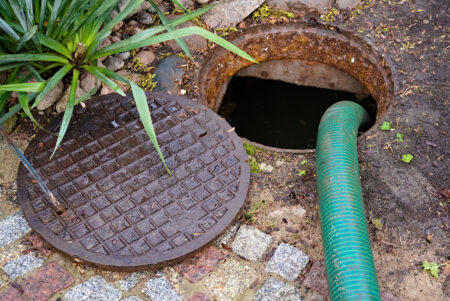How to Prevent Sewer Backups

Every drain in your Nacogdoches, TX home converges onto your outdoor sewer line. This line travels underground from your residence to the municipal sewer system. Unfortunately, if your sewer line ever cracks, collapses, or develops a major obstruction, all of your effluence will come rushing back into the building. The good news is that there are six ways to keep these dangerous whole-house backups at bay.
1. Schedule Regular Drain Cleaning and Sewer Line Inspection Services
Whether performed with mechanized tools or hot, high-pressure water or steam, annual drain cleaning sloughs off tacky in-pipe buildups of grease, limescale, soap scum, biofilm, and hair. Many of these treatments force in-pipe accumulations toward the municipal sewer main. They widen the diameter of pipe interiors so that wastewater and solid waste have plenty of room to move. Drain cleaning additionally eliminates unpleasant drain odors, minimizes the potential for drain gnat infestations, and staves off common problems like slow-moving drains and clogs. Best of all, it keeps waste moving in the right direction.
Regular sewer line inspections are helpful for preventing whole-house backups as well. During these services, plumbers send special camera equipment into sewer lines to look for offset pipes, invasive tree roots, and cracked pipe sections. Identifying structural sewer line problems early on allows plumbers to resolve them before backups occur.
2. Plant Responsibly
All trees should be planted at least 10 feet away from residential sewer lines and other underground utilities. For assured safety, you can even consult with a plumbing professional before adding new trees to your landscape. Planting trees a safe distance away from sewer lines gives their roots plenty of room to grow without encroaching upon pipes.
Practice Good General Landscape Maintenance
The nutrient-dense contents of sewer lines are appealing to both tree roots and underground weeds. These growths search for weak spots in sewer pipes to access the moisture in their interiors. In addition to responsible planting, you should regularly remove weeds from your yard.
Tree Stumps Could Be an Issue, Too
Tree roots can continue growing long after trees have been cut down. To protect your sewer line, invest in professional stump grinding services that eliminate both stumps and their subterranean root systems.
3. Limit What You Send Down Your Drains
Many common consumer products that are marketed as “flushable” aren’t really safe for plumbing drains. Even if these items successfully clear your toilets, they aren’t guaranteed to pass through your sewer line. Things like “flushable” self-care wipes, feminine hygiene products, and prophylactics can get snagged on invasive root systems or rough pipe interiors and cause blockages. The only things that you should flush down your toilets are human waste and toilet paper.
In the kitchen, never put grease or cooking oils down your drains. As they cool and solidify, these things can create tough, tacky buildups in pipe interiors or cause pipe and sewer line blockages.
4. Avoid Placing Heavy Equipment on Your Sewer Line
Although some sewer lines are buried up to 6 feet deep, others may lie just 12 to 30 inches below the surface. Placing heavy equipment directly on top of your sewer line could cause soil compaction that offsets pipe sections.
You can work with a plumber or an underground utility locating service to identify the exact location of your sewer line. Never place a stump grinder, play structure, concrete pad, or shed on top of this feature.
5. Replace Old, Outdated Sewer Pipes
Most sewer pipes last at least 50 years. Some can last a full century. However, if you have excessively hard water in your home and have yet to install water-softening equipment, heavy accumulations of dissolved minerals could shorten your sewer line’s lifespan. Dramatic temperature fluctuations, insufficient depth, and earth shifting can also shorten the lifespans of sewer pipes. It’s always best to replace these features before they crack, collapse, or develop major blockages.
6. Recognize the Signs of an Impending Whole-House Backup
Whole-house sewer backups and the problems that cause them rarely develop overnight. Be on the lookout for the signs of an impending backup, including:
- Gurgling or bubbling noises coming from plumbing fixtures
- Malfunctioning appliances
- Multiple slow-moving or clogged drains
- Foul drain odors
Other signs of an impending whole-house backup include noxious sewer gases in your yard, wet, marshy terrain, and sudden increases in grass or other growth along your sewer line.
With a service history that spans more than 60 years, we’re proud to help homeowners in Nacogdoches, TX maintain high-functioning plumbing systems. In addition to plumbing installation and repair services, we offer air conditioning, heating, sheet metal, and indoor air quality services. Our clients can count on us for expert sewer line inspections, sewer cleaning, and backflow prevention. To schedule an appointment, contact Nacogdoches Sheet Metal, Plumbing & Air Conditioning, LTD. today.
